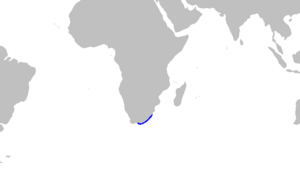Natal shyshark facts for kids
Quick facts for kids Natal shyshark |
|
|---|---|
| Conservation status | |
| Scientific classification | |
| Genus: |
Haploblepharus
|
| Species: |
kistnasamyi
|
 |
|
| Range of the Natal shyshark | |
The Natal shyshark, also called the eastern shyshark or happy chappie, is a type of catshark. It belongs to the family called Scyliorhinidae. This shark was once thought to be just a different version of the puffadder shyshark found in the Natal region.
This special shark lives only in a small area off the coast of South Africa. You can find it from the Western Cape to KwaZulu-Natal. It stays close to the coast, from where waves break to about 30 meters (100 feet) deep. It likes to live on the bottom of the ocean. The Natal shyshark can grow up to 50 centimeters (20 inches) long. It looks a lot like the puffadder shyshark but has a stronger body and a tail section that is flatter on the sides. Its colors are also different. This shark is rare and is considered Vulnerable by the International Union for Conservation of Nature (IUCN). This means it is at risk because its home is being damaged and it is caught by fishing boats.
Contents
Discovering the Natal Shyshark
For a long time, scientists thought the Natal shyshark was just a different kind of puffadder shyshark. They noticed that the sharks found near Natal looked a bit different and lived in different places than the main puffadder sharks.
In 2006, two scientists, Brett A. Human and Leonard J.V. Compagno, officially named this shark as a brand new species. They wrote about their discovery in a science magazine called Zootaxa. They named the shark after Nat Kistnasamy, a South African shark expert who first found it.
Where the Natal Shyshark Lives
The Natal shyshark lives only in the waters off the KwaZulu-Natal province in South Africa. It might also be found in the Western Cape and Eastern Cape Provinces. Scientists believe its total home area is smaller than 100 square kilometers (39 square miles).
This shark lives on the ocean floor. You can find it in the surf zone (where waves break) and on shallow rocky reefs. Unlike the puffadder shyshark, which prefers deeper, cooler waters, the Natal shyshark lives in warmer, shallower waters. It stays at depths from 0 to 30 meters (0 to 100 feet).
What the Natal Shyshark Looks Like
The Natal shyshark looks very much like the puffadder shyshark. However, it has a more solid body and a head that is not as flat. The part of its body before the tail, called the caudal peduncle, is flatter from side to side.
Its snout (nose area) is wide and round. It has very large nostrils with big, triangular skin flaps that reach its mouth. There are deep grooves under these flaps that go from the nostrils to the mouth. The mouth has small folds at the corners of both jaws. Its teeth have 3 to 5 points. The shark's eyes are large and have a special protective third eyelid. There is also a clear ridge below its eyes. The five gill slits are placed a bit high up on its body.
The fins on its back (dorsal fins), belly (pelvic fins), and under its tail (anal fin) are all about the same size. The dorsal fins are set far back on its body. The first one starts behind the pelvic fins, and the second one starts behind the anal fin. Its side fins (pectoral fins) are medium-sized. The tail fin is short and wide. It has a small dip on the top part and a less clear bottom part.
The shark's skin is thick and covered in small, leaf-shaped scales called dermal denticles. Its back is brown with a special pattern of dark brown, H-shaped marks. These marks have clear edges. There are also many small white dots and darker spots between the H-shaped marks. This shark can grow up to 50 centimeters (20 inches) long.
Natal Shyshark Behavior and Life
The Natal shyshark is rarer than the puffadder shyshark, so scientists don't know much about its daily life. Male Natal shysharks are ready to have babies when they are about 50 centimeters (20 inches) long. Females are ready when they are about 48 centimeters (19 inches) long.
Shysharks get their name because they curl up into a ring and cover their eyes with their tails when they feel scared or threatened.
Threats to the Natal Shyshark
The Natal shyshark lives in a very small area. This area is threatened by changes to its home, especially near Durban. This is because industries and tourism are growing quickly there. Also, a lot of fishing happens in this region, especially for prawns.
Because it lives in such a small area and likely has a small population, the International Union for Conservation of Nature (IUCN) has listed the Natal shyshark as Vulnerable. This means it is at a high risk of becoming extinct if its habitat continues to be damaged and fishing continues at current levels.
Images for kids



